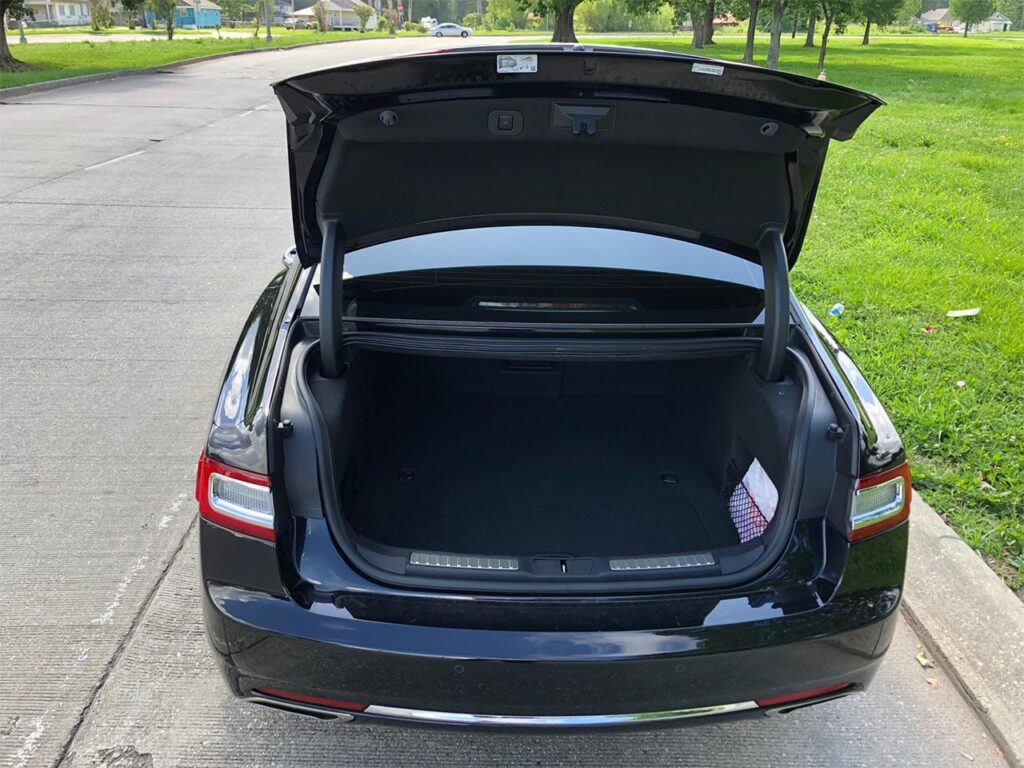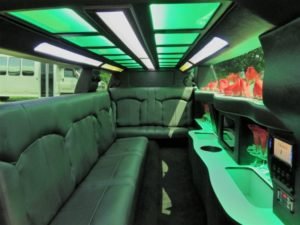Have you ever wondered what’s inside the trunk of a limo? Well, prepare to be surprised! Contrary to popular belief, a limo does have a trunk, but it’s not your ordinary trunk. It’s a hidden compartment that’s specifically designed to provide a seamless and luxurious experience for passengers.
When it comes to the trunk of a limo, there’s more than meets the eye. Not only does it serve as storage space for luggage and personal belongings, but it also houses various amenities that enhance the overall comfort of passengers. From minibars and entertainment systems to extra seating and luxurious upholstery, the trunk of a limo is ingeniously transformed into a functional and opulent space to cater to the needs and desires of its esteemed occupants.

Does a Limo Have a Trunk?
When it comes to luxury transportation, limousines are often the vehicle of choice. These elegant and spacious cars offer a comfortable and stylish way to travel for various occasions, such as weddings, proms, and corporate events. However, one question that often arises is whether or not a limo has a trunk. In this article, we will delve into the details of limousine design and functionality to answer this common inquiry.
Understanding Limousine Design
Limousines are typically elongated versions of luxury sedans or SUVs, designed to provide ample space for passengers and incorporate additional features. The design of a limousine varies depending on the model and purpose, whether it’s a stretch limo, SUV limo, or party bus. These vehicles often have additional doors, increased seating capacity, and various amenities to enhance the overall experience.
While some traditional sedans may have a separate trunk compartment, limousines are typically designed differently. Instead of a conventional trunk, limos often feature a spacious cargo area directly behind the passenger compartment. This area is accessible through a separate door, allowing for easy loading and unloading of luggage, equipment, or other belongings.
In some cases, particularly with larger limos or party buses, there may be a designated luggage compartment located at the rear of the vehicle. This compartment is separate from the passenger area and provides secure storage for luggage during transportation. The presence of a dedicated luggage space ensures that passengers can enjoy a comfortable and unobstructed interior while traveling.
The Benefits of not Having a Trunk
While the absence of a traditional trunk may seem unconventional, it actually offers several advantages for limousine passengers. Firstly, it allows for a more spacious and luxurious interior. By eliminating the separation between the passenger compartment and the trunk, limos can provide a larger seating area and more legroom, ensuring that occupants can relax and enjoy the ride.
Additionally, the lack of a trunk allows for easier access to the cargo area. Passengers can conveniently load and unload their belongings without the need to navigate around seats or squeeze through tight spaces. This feature is especially valuable for events where luggage, equipment, or other items need to be transported, such as airport transfers or corporate outings.
Furthermore, the absence of a trunk gives limousines a distinct aesthetic appeal. The elongated design of these vehicles, combined with the uninterrupted flow from the passenger area to the cargo space, creates a sleek and stylish look that is synonymous with luxury and sophistication.
The Role of the Chauffeur
In addition to understanding the design and functionality of limousines, it is essential to acknowledge the role of the chauffeur. When traveling in a limo, a professional driver is responsible for navigating the roads, ensuring the safety of the passengers, and providing excellent service. The chauffeur takes care of all logistics, including loading and unloading luggage or other items when necessary.
Chauffeurs are trained to handle all aspects of limo transportation, from opening doors to assisting with luggage. Their primary focus is on delivering a smooth and comfortable experience for passengers. Therefore, even though a limo may not have a conventional trunk, the presence of a chauffeur ensures that all items are securely stored and readily accessible whenever needed.
The Convenience of Professional Service
One of the significant benefits of traveling in a limousine is the convenience of professional service. Whether it’s carrying luggage, managing logistics, or providing a comfortable ride, the presence of a chauffeur ensures that passengers can relax and enjoy the journey without any concerns. The dedicated service offered by limousine companies allows individuals to rely on reliable and efficient transportation for special occasions or business needs.
Furthermore, the spacious cargo area in limousines provides ample room for belongings without compromising passenger comfort. Passengers can bring along their luggage, equipment, or other items without feeling cramped or restricted. This convenience ensures that individuals have everything they need for their trip, whether it’s a weekend getaway or an important business event.
The Evolution of Limousine Design
Over the years, limousine design has evolved to cater to the changing needs and preferences of passengers. Each new model or variation of the classic limo offers innovative features and improvements that enhance the overall experience. In this section, we will explore some of the key developments in limousine design.
Modern Amenities and Technological Advancements
One of the notable changes in limousine design is the incorporation of modern amenities and technological advancements. Today, limos are equipped with state-of-the-art entertainment systems, including high-definition screens, surround sound, and even karaoke machines. Passengers can enjoy their favorite movies or music, creating a fun and entertaining atmosphere during the ride.
In addition to entertainment features, modern limousines often include advanced climate control systems, mood lighting options, and customized interiors. These amenities allow passengers to personalize their experience and create the desired ambiance for their occasion. Whether it’s a romantic evening, a party celebration, or a professional business meeting, the interior of a modern limo can be tailored to meet specific preferences.
Furthermore, limousines now integrate various connectivity options, such as USB ports, Bluetooth capabilities, and Wi-Fi access. This connectivity allows passengers to stay connected, whether it’s for business purposes or simply to browse the internet or stream their favorite content. The inclusion of these technological features enhances the overall convenience and comfort of traveling in a limo.
Green and Sustainable Limos
In recent years, there has been a growing emphasis on sustainability and eco-friendly transportation. This trend has also influenced the design of limousines, leading to the development of green and sustainable models. Limousine manufacturers have started incorporating hybrid or electric engines into their vehicles, reducing carbon emissions and promoting environmental stewardship.
Green limos not only minimize their impact on the environment but also offer certain advantages for passengers. Electric limos, for example, have reduced noise levels compared to traditional gasoline or diesel engines. This feature enhances the overall tranquility and comfort of the ride, allowing passengers to relax and enjoy the journey without excessive noise pollution.
Furthermore, sustainable limos often employ innovative materials and design techniques to increase fuel efficiency. Lighter materials and aerodynamic features contribute to better fuel economy, ensuring that passengers can travel for longer distances while minimizing environmental impact.
The Rise of Customization
An emerging trend in limousine design is the emphasis on customization. Limousine manufacturers now offer a range of options to personalize the vehicle according to individual preferences and requirements. Customers can choose from a variety of color schemes, upholstery materials, lighting options, and even interior layouts.
Customization allows passengers to create a unique and tailored experience that aligns with their style and event. Whether it’s a sleek and modern look for a corporate outing or a vibrant and festive ambiance for a wedding celebration, the ability to customize the limo ensures that the vehicle complements the occasion and reflects the individual’s taste.
Furthermore, customization extends beyond the visual aspects of the limo. Customers can also choose specific amenities and features to enhance their experience. From built-in bars and refrigerators to massage chairs and privacy partitions, the options for customization are vast, ensuring that every ride in a custom limo is truly one-of-a-kind.
Statistic:
According to a report by Allied Market Research, the global limousine market is expected to reach $9.8 billion by 2027, with a compound annual growth rate (CAGR) of 4.8% from 2020 to 2027. This growth is driven by the increasing demand for luxury transportation services and the growing popularity of limousines for events and corporate travel.
Key Takeaways: Does a Limo Have a Trunk?
- A limo usually has a trunk for storing luggage.
- The trunk in a limo is typically located at the rear of the vehicle.
- The trunk space in a limo can vary depending on the model and size of the vehicle.
- The trunk is separate from the passenger area in a limo.
- The trunk in a limo is designed to accommodate the needs of passengers and their belongings.
Frequently Asked Questions
Are you curious about whether a limo has a trunk? We’ve got the answers for you right here! Check out these frequently asked questions about limousine trunks.
1. Where is the trunk located in a limo?
In most limousines, the trunk is located at the rear of the vehicle. It is a separate compartment that is accessible from the outside. The trunk provides additional storage space for luggage and other belongings.
The location of the trunk may vary slightly depending on the specific limousine model. Some limousines may have a front trunk or a mid-trunk configuration, but the majority of them have the trunk at the back.
2. How big is the trunk space in a limousine?
The size of the trunk space in a limousine can vary depending on the make and model of the vehicle. Generally, limousine trunks are designed to accommodate luggage and other large items.
A typical limousine trunk can hold multiple suitcases, bags, and other belongings. However, it’s important to note that the trunk space in a limousine may be more limited compared to a regular sedan or SUV.
3. Can passengers access the trunk from inside the limousine?
No, passengers cannot directly access the trunk from inside the limousine. The trunk is usually accessed from the outside of the vehicle, primarily by the chauffeur or driver.
The primary purpose of the trunk in a limousine is to provide storage for luggage and personal belongings during transportation. Passengers are generally not allowed to access the trunk area for safety and security reasons.
4. What are some common items stored in a limousine trunk?
Common items stored in a limousine trunk include luggage, bags, and other personal belongings of the passengers. The trunk space is designed to accommodate these items and keep them secure during the journey.
In addition to passenger belongings, limousine trunks may also store other items such as spare tires, emergency kits, and chauffeur necessities like umbrellas and cleaning supplies.
5. Are limousine trunks secure?
Yes, limousine trunks are typically secure. They are designed to keep passenger belongings safe during transportation. Most limousine companies have security measures in place to protect the trunk area, such as locks and alarm systems.
However, it’s always a good idea for passengers to take necessary precautions and keep valuable items with them inside the main seating area of the limousine, rather than storing them in the trunk.






